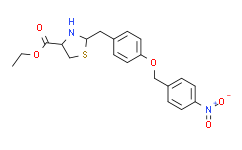SN 6 is a selective Na/Ca exchanger inhibitor, which inhibits the initial rate of Ca uptake into NCX1, NCX2, and NCX3 transfectants with IC50 values of 2.9 ± 0.12, 16 ± 1.1, and 8.6 ± 0.27 μM. SN 6 (up to 30 μM) also less potently inhibits muscarinic acetylcholine receptor, with a higher IC50 of 18 μM. SN 6 (0.3-30 μM) completely inhibits the initial rate of Nai-dependent Ca uptake into Na-loaded sarcolemmal vesicles in a dose dependent manner (IC50, 5.3 ± 0.37 μM). SN 6 (0.3-10 μM) dose-dependently protects against the hypoxia/reoxygenation-induced LDH release in parental LLC-PK1 cells and NCX1 transfectants but not in K229Q transfectants. SN 6 (1-30 μM) suppresses the bidirectional outward and inward INCX in a concentration-dependent manner, with IC50 values of 2.3 μM and 1.9 μM, respectively. SN 6 also inhibits bidirectional current (INCX) in a [Na]i concentration-dependent manner, with IC50 values of 3.4 μM, 2.3 μM, and 1.1 μM at 10 mM, 20 mM, and 30 mM [Na]i, respectively. SN 6 inhibits hypoxia/reoxygenation-induced LDH release with an IC50 value of 0.63 ± 0.15 μM in NCX1 transfectants.
Medlife has not independently confirmed the accuracy of these methods. They are for reference only.



 扫码关注公众号
扫码关注公众号